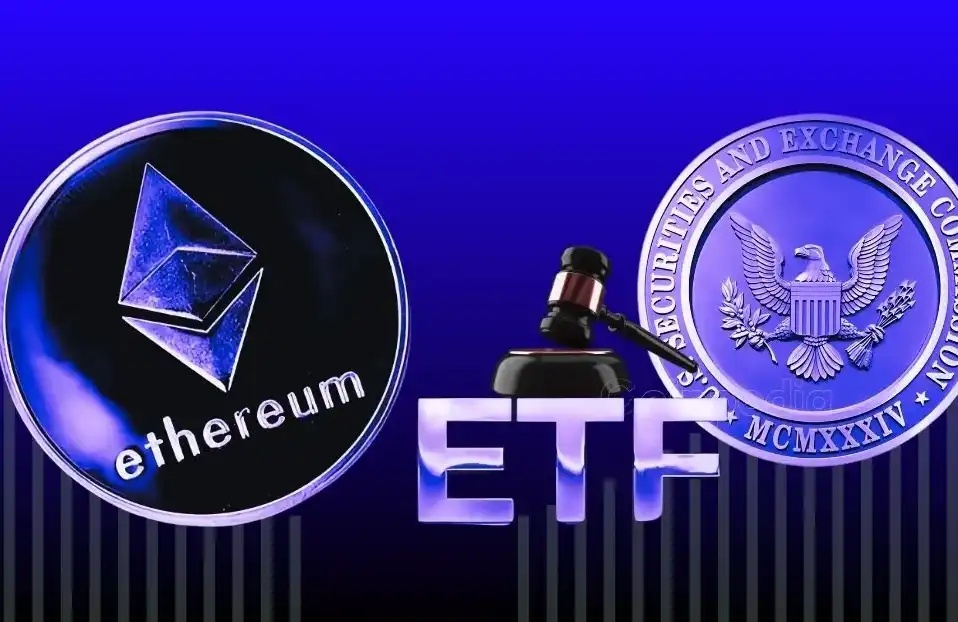If BlackRock's ETH Staking ETF is approved, what impact will it have on Ethereum?
On July 17, global asset management giant BlackRock once again made a precise move—its iShares Ethereum Trust Fund (ETHA) formally submitted a 19b-4 filing to the U.S. Securities and Exchange Commission (SEC), intending to introduce a staking feature for its Ethereum ETF.
Although prior to this, peer institutions including Franklin Templeton, Grayscale, 21Shares, and Fidelity had already submitted similar proposals, when BlackRock joined the fray, market sentiment instantly heated up. The reason is simple: BlackRock may not be the quickest mover, but it always ends up being the one that "successfully crosses the finish line," reigniting external expectations for the SEC to approve staking-based crypto ETFs.
According to analyst estimates, the SEC is expected to provide an initial response to early staking proposals before October of this year. If the review progresses smoothly, formal approval could possibly be expedited to the fourth quarter of 2025.
Currently, the total assets under management of Ethereum spot ETFs have surpassed $17 billion, with ETHA dominating at a scale of $8.7 billion. If the staking feature is approved, it will not only reshape Ethereum's investment logic but also inject new growth momentum into the entire on-chain ecosystem. This article will focus on this historical turning point, systematically outlining which tracks and projects will be the first to benefit from the introduction of staking in the Ethereum ETF.

From Speculative Tool to Yield Asset, ETH's Asset Properties Are Being Reshaped
For ETH, the introduction of a staking ETF could signify a structural reassessment of its asset nature.
Compared to traditional financial assets, Ethereum possesses a "native advantage"—it is not only a speculative asset but can also earn staking rewards through on-chain validation, with the current annualized return rate being approximately 3.5%. Once the ETF is approved to introduce a staking mechanism, its investment logic will transition from a singular price growth expectation to a dual-engine driving force of "price + yield." This model is similar to holding government bonds to earn interest or holding blue-chip stocks to receive dividends, and will become the first U.S. cryptocurrency ETF to provide returns to institutional and retail investors. This transformation may turn Ethereum into a regulated investment tool that generates yield, making it an attractive option in traditional finance.
Eric Jackson, founder of EMJ Capital, has predicted that Ethereum could hit $10,000 or even higher in this cycle. His model attributes ETH's potential growth momentum to four main factors: its stable 3.5% staking yield, the net negative issuance trend since the merger, the additional demand brought by the soon-to-be-approved staking ETF, and the network activity growth driven by Layer 2 and tokenized assets. The Jackson team points out that the supply-demand structure of ETH is rapidly tightening, and if the ETF progresses ahead of schedule, combined with the widespread adoption of Layer 2, ETH breaking $15,000 in the next few quarters is not a fantasy.
Who Is the Real Winner in the Staking Race
Liquidity Staking Protocol
Within the Ethereum ETF, integrating staking functionality, the greatest technical and operational challenge lies in liquidity management. Unlike the "T+0 tradability" feature of traditional financial assets, once ETH is staked, it is locked in the network and exiting requires a formal unstaking process. According to the Ethereum protocol design, when a validator chooses to exit their stake, they must wait through stages such as queuing for block production, block confirmation, and the exit queue being subject to the network's current load—during peak times, this process might last for days or even weeks.
This poses a tricky issue for ETF issuers. ETF products need to ensure that users can buy, sell, and redeem their shares at any time. However, if a significant amount of ETH held by the fund is locked in staking and faces sudden large-scale redemption requests, the fund may not be able to liquidate assets quickly, thus encountering liquidity mismatch risk.
To address this issue, ETFs usually reserve some unstaked ETH as a liquidity buffer, but this sacrifices staking rewards, weakening the product's intended attractiveness of "on-chain rewards." A more practical solution is to utilize a Liquidity Staking Derivatives (LSD) protocol.

The core mechanism is to generate tradable "staking receipt" tokens (such as Lido's stETH, Rocket Pool's rETH) representing ownership of staked ETH, allowing these tokens to be traded on the secondary market, thereby maintaining on-chain liquidity for the staked assets. If an Ethereum ETF uses an LSD protocol, it can not only continuously earn staking rewards but also meet redemption demands at any time through derivative assets like stETH, addressing the liquidity pain point of traditional staking. This makes the LSD protocol a key "liquidity intermediary" between ETFs and the Ethereum network.

The market has swiftly responded to this logic. After BlackRock's submission of an ETH staking application was announced, Lido's governance token LDO surged over 20% within 24 hours, showing that funds are rapidly flowing into the potentially benefiting LSD sector. Once the SEC formally approves an Ethereum ETF supporting staking, protocols like Lido and Rocket Pool are expected to see significant TVL expansion, and their native tokens will undergo a new round of valuation reassessment.

Centralized Exchange Platform
The Ethereum ETF issuer has chosen not to build their own nodes or rely on decentralized protocols. The most practical and convenient solution is to use centralized staking service providers such as Coinbase and OKX. These platforms have established node infrastructure that can provide institutional clients with a one-stop staking solution, including node operation, reward distribution, key management, etc., greatly reducing the technical threshold.
Taking Coinbase as an example, its introduced liquidity staking token, cbETH (Coinbase Wrapped Staked ETH), provides users with a way to simultaneously earn staking rewards and maintain on-chain liquidity. cbETH represents the user's staked ETH on Coinbase, allowing users to transfer, trade, or use it for on-chain interactions without unstaking. The principle is similar to Lido's stETH, but issued and managed by a regulated centralized platform, making it more easily acceptable to regulatory bodies and more in line with the compliance requirements of traditional financial institutions.

Other exchanges such as Kraken and OKX also provide similar staking services and can offer customized solutions for institutional users. It is worth noting that although centralized staking services have obvious advantages in terms of convenience and compliance, they also face certain risks. For example, the SEC has taken enforcement actions against centralized exchange platforms' staking services, alleging that they constitute "unregistered securities issuance."

Overall, against the backdrop of increasingly stringent compliance requirements, centralized exchange platforms, with their technical maturity and licensing resources, remain one of the important options for ETF issuers to achieve on-chain staking functionality. Products like cbETH, in particular, may in the future become representative assets that combine liquidity and returns in the "compliant LSD" track.
Conclusion
The strong anticipation of Ethereum ETF staking not only signifies that traditional finance has officially entered the "era of on-chain yield" but also marks a complete transformation of ETH from a speculative asset to a yield-bearing asset. As institutions like BlackRock lead the way into this arena, LSD protocols, node operators, and centralized exchange platforms are stepping into the spotlight, ushering in a new phase of valuation reassessment.
As regulation gradually clarifies and infrastructure improves, this multi-party collaboration around "ETH Staking Yield" may become a key convergence point between Web3 and Wall Street. Whoever can be the first to win ETF partnership resources will occupy a more central position in the next crypto cycle.
Welcome to join the official BlockBeats community:
Telegram Subscription Group: https://t.me/theblockbeats
Telegram Discussion Group: https://t.me/BlockBeats_App
Official Twitter Account: https://twitter.com/BlockBeatsAsia
 Forum
Forum OPRR
OPRR Finance
Finance
 Specials
Specials
 On-chain Eco
On-chain Eco
 Entry
Entry
 Podcasts
Podcasts
 Activities
Activities









